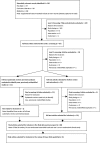Systematic Literature Review of AbobotulinumtoxinA in Clinical Trials for Lower Limb Spasticity
- PMID: 26765447
- PMCID: PMC4718273
- DOI: 10.1097/MD.0000000000002468
Systematic Literature Review of AbobotulinumtoxinA in Clinical Trials for Lower Limb Spasticity
Abstract
To elucidate clinical trial efficacy, safety, and dosing practices of AbobotulinumtoxinA (ABO) treatment in adult patients with lower limb spasticity.A systematic literature review was performed to identify randomized controlled trials of ABO in the treatment of adult lower limb spasticity.Of the 295 records identified, 6 primary publications evaluated ABO for the management of lower limb spasticity of various etiologies and were evaluated. Total ABO doses ranged between 500 and 2000 U for lower limb spasticity, depending on the muscles injected. All studies in lower limb spasticity showed statistically significant reduction in muscle tone based on Modified Ashworth Scale of ABO versus placebo. Significant effects on active movement and pain were demonstrated albeit less consistently. ABO was generally well tolerated across the individual studies; most adverse events reported were considered unrelated to treatment. Treatment-related adverse events included but not limited to fatigue, local pain at injection site, hypertonia, dry mouth, weakness of the noninjected muscle, abnormal gait, and urinary tract infection.These data from 6 randomized clinical studies provide the beginnings of an evidence base for the use of ABO to reduce lower limb spasticity. Ongoing studies in this area will add to this evidence base.
Figures
References
-
- Pathak M, Truong D. Brashear A, Elovic E. Anatomic correlation of common patterns of spasticity. Demos Medical, Spasticity Diagnosis and Management. New York:2011.
-
- Hara Y. Deep venous thrombosis in stroke patients during rehabilitation phase. Keio J Med 2008; 57:196–204. - PubMed
-
- Royal College of Physicians, British Society of Rehabilitation Medicine, Chartered Society of Physiotherapy, Association of Chartered Physiotherapists Interested in Neurology. Spasticity in adults: management using botulinum toxin. National guidelines. London: RCP, 2009.
Publication types
MeSH terms
Substances
LinkOut - more resources
Full Text Sources
Other Literature Sources
Medical


